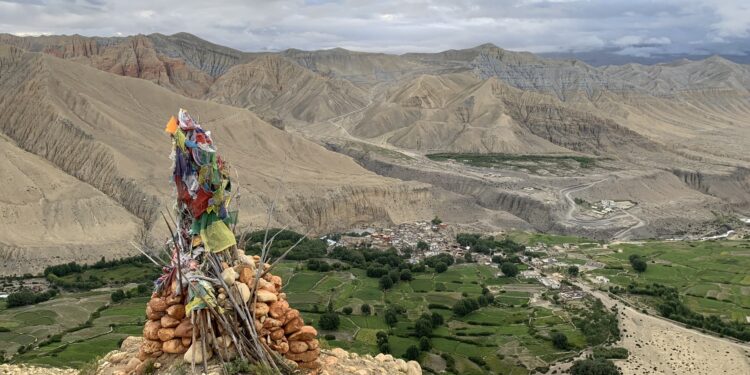View of a Tibetan village from the Himalayas. Credit: James Yu
Breathing rarefied air at extreme altitudes presents a significant challenge: there is simply less oxygen with each breath. Yet for over 10,000 years, Tibetan women living on the Tibetan high plateau have not only survived but thrived in this environment.
A study led by Cynthia Beall, distinguished professor emeritus at Case Western Reserve University, answers some of these questions. The research, published in the journal Proceedings of the National Academy of Sciences of the United States of Americareveals how the physiological traits of Tibetan women enhance their ability to reproduce in such a low-oxygen environment.
The findings, Beall said, not only highlight the remarkable resilience of Tibetan women, but also provide valuable insights into how humans can adapt in extreme environments. Such research also offers clues about human development, how we might respond to future environmental challenges, and the pathobiology of people with diseases associated with hypoxia at all altitudes.
“Understanding how populations like these adapt,” Beall said, “allows us to better understand the processes of human evolution.”
Beall and his team studied 417 Tibetan women aged 46 to 86 who live between 12,000 and 14,000 feet above sea level in a location in Upper Mustang, Nepal, on the southern edge of the Tibetan Plateau.
They collected data on the women’s reproductive history, physiological measurements, DNA samples and social factors. They wanted to understand how oxygen delivery characteristics in the face of high altitude hypoxia (low levels of oxygen in the air and blood) influence the number of live births, a key measure of evolutionary fitness. .
Adaptation to rarefied air
They found that women who had the most children had a unique set of blood and heart characteristics that helped their bodies provide oxygen.
Women reporting the most live births had levels of hemoglobin, the molecule that carries oxygen, close to the sample average, but their oxygen saturation was higher, allowing for a more efficient delivery of oxygen to the cells without increasing blood viscosity; the thicker the blood, the more strain on the heart.
“This is a case of continuing natural selection,” said Beall, also the Sarah Idell Pyle Professor of Anthropology at the university. “Tibetan women have evolved in ways that balance the body’s oxygen needs without overloading the heart.”
A window into human evolution
Beall’s interdisciplinary research team, which included longtime collaborators Brian Hoit and Kingman Strohl of the Case Western Reserve School of Medicine, as well as other U.S. and international researchers, conducted field work in 2019 The team worked closely with local communities in the Nepalese Himalayas, hiring locals. women as research assistants and collaborating with community leaders.
One genetic trait they studied likely came from the Denisovans who lived in Siberia around 50,000 years ago; their descendants then migrated to the Tibetan plateau.
This trait is a variant of the EPAS1 gene unique to populations indigenous to the Tibetan Plateau and regulates hemoglobin concentration. Other features, such as increased blood flow to the lungs and larger heart ventricles, further improve oxygen delivery.
These traits have contributed to greater reproductive success, offering insight into how humans adapt to persistently low oxygen levels in the air and in their bodies.
More information:
Beall, Cynthia M., Higher oxygen content and transport characterize high-altitude Tibetan women with greatest lifetime reproductive success, Proceedings of the National Academy of Sciences (2024). DOI: 10.1073/pnas.2403309121. doi.org/10.1073/pnas.2403309121
Provided by Case Western Reserve University
Quote: Evolution in Action: How Tibetan Women Thrive in Thin High-Altitude Oxygen (October 21, 2024) retrieved October 21, 2024 from
This document is subject to copyright. Except for fair use for private study or research purposes, no part may be reproduced without written permission. The content is provided for informational purposes only.



